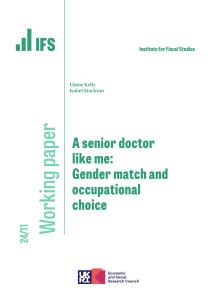The COVID-19 pandemic is having long-lasting impacts on NHS hospital activity, productivity and performance in Scotland. The Scottish NHS handled 8% fewer emergency admissions, elective day patients and outpatient appointments, as well as 21% fewer elective inpatient admissions, in April–June 2023 than pre-pandemic. That was despite health spending per person being at least 10% higher in real terms in 2022–23 than in 2019–20, and the NHS employing 9% more consultants and 6% more nurses in April–June 2023 than in 2019. This is suggestive of a significant fall in hospital productivity.
These are among the findings of new analysis of Scottish health spending, staffing and activity, published today as part of the Institute for Fiscal Studies’ second annual Scottish Budget Report. Other key findings include:
- The number of patients on the elective waiting list in Scotland has grown by 87% since the start of the pandemic. The shares waiting more than 18 weeks for elective treatment and more than four hours in A&E departments have also grown substantially (although, at 36%, the share waiting more than four hours in A&E remains lower than the 45% in England). Until the NHS delivers more hospital activity than pre-pandemic, it is likely waiting lists and times in Scotland will continue to rise.
- The fall in measured hospital productivity in Scotland since the start of the pandemic is similar in magnitude to that previously documented in the English NHS. But England has increased staffing by more than Scotland, so the recovery in hospital activity has been much greater in England than in Scotland. For example, in the first half of 2023, the English NHS delivered 4% more outpatient appointments than in 2019, while the Scottish NHS delivered 6% fewer.
- Health spending and resources are likely to have to increase to meet cost and demographic pressures. But the last Scottish health and social care workforce plan, published in 2022, aims to increase the NHS workforce by just 1% over the succeeding five years, compared with the 20–21% increase implied by the England NHS workforce plan over the same period. What actually happens to NHS staffing in both countries may well differ from these official plans, but they are strikingly different.
- Scotland has consistently spent more per person on health than England since the start of devolution, but this gap has fallen over time. In 1999–2000, Scotland spent 22% more than England, but this had fallen to 3% in 2019–20 on the eve of the pandemic, according to official estimates. Projecting forwards, we estimate that budgets for next year imply that Scotland will also spend around 3% more per person than England in 2024–25. In the two years before the COVID-19 pandemic, Welsh health spending per person overtook Scottish spending for the first time since devolution, and in 2024–25 plans appear to be around 11% higher.
Max Warner, a Research Economist at IFS and an author of the report, said:
‘The Scottish NHS is still feeling the effects of the COVID-19 pandemic. Despite higher funding and more staff than in 2019, hospital activity remains substantially below pre-pandemic levels. The fall in measured hospital productivity is similar to what we have documented for England, but the reduction in activity is larger in Scotland because funding and staffing have grown by less than in England. Many potential factors are likely contributing to hospitals treating fewer patients despite having more staff. These include a reduction in the number of available hospital beds, patients requiring more care in hospital because they are sicker than pre-pandemic, the continued presence of COVID-19 patients in hospital, and difficulties discharging patients from hospitals. Without a substantial boost to hospital productivity, there is a risk that even additional funding and staffing will not bring the Scottish NHS back to pre-pandemic performance.’










